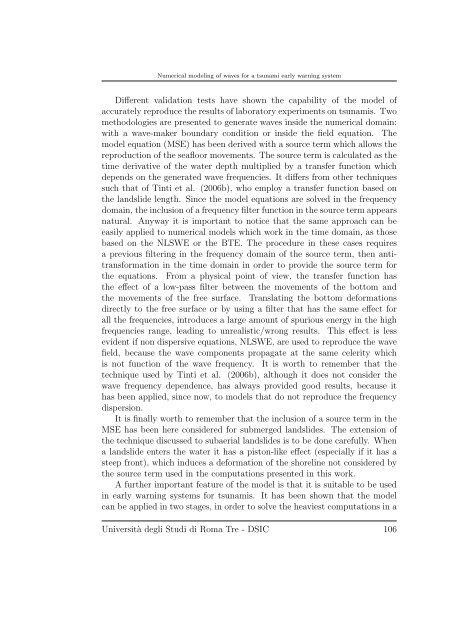Numerical modeling of waves for a tsunami early warning system
Numerical modeling of waves for a tsunami early warning system
Numerical modeling of waves for a tsunami early warning system
Create successful ePaper yourself
Turn your PDF publications into a flip-book with our unique Google optimized e-Paper software.
<strong>Numerical</strong> <strong>modeling</strong> <strong>of</strong> <strong>waves</strong> <strong>for</strong> a <strong>tsunami</strong> <strong>early</strong> <strong>warning</strong> <strong>system</strong><br />
Different validation tests have shown the capability <strong>of</strong> the model <strong>of</strong><br />
accurately reproduce the results <strong>of</strong> laboratory experiments on <strong>tsunami</strong>s. Two<br />
methodologies are presented to generate <strong>waves</strong> inside the numerical domain:<br />
with a wave-maker boundary condition or inside the field equation. The<br />
model equation (MSE) has been derived with a source term which allows the<br />
reproduction <strong>of</strong> the seafloor movements. The source term is calculated as the<br />
time derivative <strong>of</strong> the water depth multiplied by a transfer function which<br />
depends on the generated wave frequencies. It differs from other techniques<br />
such that <strong>of</strong> Tinti et al. (2006b), who employ a transfer function based on<br />
the landslide length. Since the model equations are solved in the frequency<br />
domain, the inclusion <strong>of</strong> a frequency filter function in the source term appears<br />
natural. Anyway it is important to notice that the same approach can be<br />
easily applied to numerical models which work in the time domain, as those<br />
based on the NLSWE or the BTE. The procedure in these cases requires<br />
a previous filtering in the frequency domain <strong>of</strong> the source term, then antitrans<strong>for</strong>mation<br />
in the time domain in order to provide the source term <strong>for</strong><br />
the equations. From a physical point <strong>of</strong> view, the transfer function has<br />
the effect <strong>of</strong> a low-pass filter between the movements <strong>of</strong> the bottom and<br />
the movements <strong>of</strong> the free surface. Translating the bottom de<strong>for</strong>mations<br />
directly to the free surface or by using a filter that has the same effect <strong>for</strong><br />
all the frequencies, introduces a large amount <strong>of</strong> spurious energy in the high<br />
frequencies range, leading to unrealistic/wrong results. This effect is less<br />
evident if non dispersive equations, NLSWE, are used to reproduce the wave<br />
field, because the wave components propagate at the same celerity which<br />
is not function <strong>of</strong> the wave frequency. It is worth to remember that the<br />
technique used by Tinti et al. (2006b), although it does not consider the<br />
wave frequency dependence, has always provided good results, because it<br />
has been applied, since now, to models that do not reproduce the frequency<br />
dispersion.<br />
It is finally worth to remember that the inclusion <strong>of</strong> a source term in the<br />
MSE has been here considered <strong>for</strong> submerged landslides. The extension <strong>of</strong><br />
the technique discussed to subaerial landslides is to be done carefully. When<br />
a landslide enters the water it has a piston-like effect (especially if it has a<br />
steep front), which induces a de<strong>for</strong>mation <strong>of</strong> the shoreline not considered by<br />
the source term used in the computations presented in this work.<br />
A further important feature <strong>of</strong> the model is that it is suitable to be used<br />
in <strong>early</strong> <strong>warning</strong> <strong>system</strong>s <strong>for</strong> <strong>tsunami</strong>s. It has been shown that the model<br />
can be applied in two stages, in order to solve the heaviest computations in a<br />
Università degli Studi di Roma Tre - DSIC 106

















